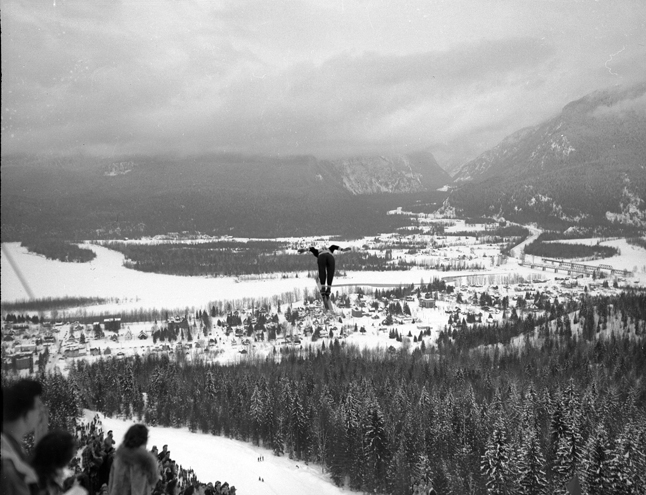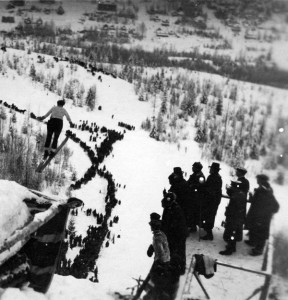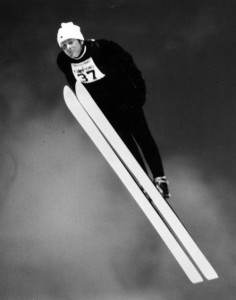
The following is another brief excerpt from First Tracks and pertains specifically to the Arnfinn Bergman photo.
Can you picture an effort like this? A man rushing down a smoothened, hardened steep snow-incline on wax-boarded feet. With hands clenched in front of him he crouches, crouches, as he approaches the starting take-off. He heaves his hands backwards for further momentum – he brings them together again for steadiness of poise – and, as he reaches the edge of the air abyss – his tensed, trained muscles jump with his will – and in the next small fraction of a second he is over the brink and soaring like a bird in the air – a hundred feet above the spectators heads – and, by poise of every member resisting gravity laws, and inclining himself to meet the inevitable impact which measure the distance of his jump, he touches the ground and is off like lightning on the runway.
Revelstoke Review, February 1, 1917
The creation of the Big Hill
When Thorlief Iversen visited Revelstoke during the first Winter Carnival, he and Nels Nelsen identified a natural jumping site on Mount Revelstoke that Iversen described as “one of the finest in the world.” The steep – but not rocky – hillside had a natural take-off location and a long landing stretch. It was near the town and railway, which would bring visitors in special ‘ski trains’ from Vancouver and Calgary. Also, Revelstoke could be counted on to have plenty of snow, which was both a blessing and a curse as continuous snow added greatly to the hill grooming workload.
- Editor’s Note:
The Revelstoke Museum & Archives is soon unveiling its new book First Tracks and graciously permitted The Current to publish an excerpt for your reading pleasure. Enjoy!
The creation of the Big Hill
When (ski jumping judge) Thorlief Iversen visited Revelstoke during the first Winter Carnival, he and (jumping champion) Nels Nelsen identified a natural jumping site on Mount Revelstoke that Iversen described as “one of the finest in the world.” The steep – but not rocky – hillside had a natural take-off location and a long landing stretch. It was near the town and railway, which would bring visitors in special ‘ski trains’ from Vancouver and Calgary. Also, Revelstoke could be counted on to have plenty of snow, which was both a blessing and a curse as continuous snow added greatly to the hill grooming workload.
Shortly before he died, Nelsen wrote of the establishment of the Big Hill (later nicknamed Suicide Hill):
When skiing was first introduced in the west, the public and particularly the newspapers, thought this was only another fad, like cross-word puzzles or Mah Jong, and therefore not worthy of notice. Skiing and ski jumping were to be indulged in only by those imbecile immigrants from Norway. Those of us who knew that skiing was a great sport, besides being big business, decided to make the natives ski-conscious. In order to do this, we had to have the newspapers with us. Realizing that these newspapers would become interested only if something unusual were done, we decided to build the ‘Suicide Hill.’

This ski jump at Revelstoke was built in 1915, with volunteer labor according to standards prevailing at that time, with the exception that this hill was the biggest in the world then and afterwards. The world record of 1916 – 160 feet – was promptly broken on this hill. The newspapers, which were in the habit of giving skiing a few lines on the back page, sat up and took notice. The public became interested; they read about it; they saw it in the pictures, and the doings on ‘Suicide Hill’ were great news.
Nelsen’s vision and strategy worked. Local newspapers soon espoused the great – even international – potential for the jump. In 1916, the Mail-Herald wrote, “Revelstoke has a hill which has no equal on this continent and under proper weather conditions, not only the Canadian, but the world’s record is possible of recording here.” The City of Revelstoke and the Board of Trade contributed $1,200 to help with the jump’s construction.
Significantly, the ski jump’s construction occurred around the same time that Mount Revelstoke National Park was established. The park was unusual because it was initiated by the community itself, rather than being established because of its ecological qualities. Richard Caton wrote that:
The townspeople, led by the Board of Trade, saw the park as a tourist attraction – a source of revenue for Revelstoke. It was an area to be developed by the federal government for the tourist industry of Revelstoke. The Board of Trade had definite ideas about park management and was determined to see them carried out. The people of Revelstoke constantly viewed their city as a rival to Banff, and paralleled Heather and Balsam Lakes with Lake Louise.
Because Mount Revelstoke National Park was created in this way and because many Parks Canada employees over the years were avid skiers and ski supporters, it is easy to understand Parks Canada’s support for ski jumping, downhill skiing and construction of cross-country ski trails and chalets in the park for at least the first 50 years of the park’s existence.
Floating on air: The Vorlage (forward lean)

When you come off the jump it’s like floating on air because you’ve got wind pressure, whereas on the smaller jumps you cut through the wind because you’re not going as fast.
Roland Larson, former jumper
In 1943, a few days before he died, Nels Nelsen hand wrote an article which he sent to his sister, Mrs. Joseph Beruschi, to be typed. The article, published in the Revelstoke Review on February 21, 1946, described how Nelsen and his friends developed the ‘forward lean’ on the Big Hill.
The Suicide Hill
(by Nels Nelsen, 1946)
Our younger generation fondly believes that ‘Vorlage’ came from Europe. It absolutely did not. This ‘forward lean’ was discovered and practiced on this hill in 1916. The correct style of running, and particularly of jumping, at that time was to stand straight up, forcing oneself through the air. No one up to that time had thought of, or needed to use, air pressure as a help in ski jumping.
When ‘Suicide Hill’ was opened in 1916, we jumpers who tried it out found to our surprise (rather painfully) that we were jumping against an invisible wall – a force that made us land on our backs every time. The rules said: ‘A jumper must leave the take-off standing up straight; skis parallel with the hill at all times; arms down along the sides.’
We did just that, with dire results. The jumpers (there were only a handful of us) decided that we were up against something unknown. For days we tried to get through this wall, but without success, until one of us mentioned that a rock or a flat stone, thrown edgewise, would float, whereas if thrown sideways, would promptly fall to the ground. ‘Why not try it in ski jumping. But how could anyone float on skis and present an edge to the air pressure?’ We found out. The answer was diving off the take-off and lying flat on the air pressure. The first law of ‘Vorlage’ had been discovered; the big hill was conquered; and skiing had started on another chapter.
You can order advance copies of great new book about an adventurous episode in Revelstoke history.
Go to the museum’s Facebook page to learn more.



